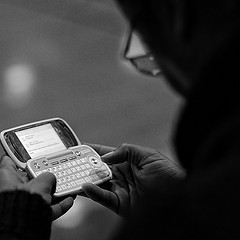
by anton | Oct 13, 2015 |
Last week, our regular blog readers (and we hope there are many of those!) will remember that I briefly described the difference between the specialist discipline of mobile advertising versus the supporting – or rather overarching – concept of mobile marketing. As we said, since the entire concept of mobile marketing and mobile advertising is relatively new in Africa, the value chain is still being determined. However, this week we look at key targets that have been determined and how they can assist with rapid market adoption of these new channels and technologies. These are: Advertising agencies, event management firms, brand managers and retailers. InTarget specifically focuses on the four segments above because their buy-in, in particular, when it comes to mobile campaigns is especially crucial when it comes to convincing their own clients of the relevance and importance of mobile marketing and mobile advertising. Only their client’s acceptance of this new medium can truly place big brands into the pockets of consumers. Engagement with the four segments is crucial if firms like InTarget are to move mobile advertising away from its historical narrow focus of mostly being about SMS-based competition entries with a good deal of text tag ads thrown in. Education of individual client service managers will convince more big brands that mobile is in fact an extremely flexible medium that can deliver faster results, more affordably, while also providing scope for significant creative input. This last part is important because television is still largely seen as the Holy Grail for creative types within agencies – every art director wants to win a Loerie for a phenomenal...

by anton | Sep 30, 2015 |
It is fairly mind-blowing when one thinks that Sub-Saharan Africa, formerly one of the poorest regions on Earth, has progressed to such an extent that today millions of human beings living here daily access the worldwide web on their mobile phones. As recently as 1994, there were just 4 million phones in the entire region. The lack of development of the region’s fixed line infrastructure meant cellular was just waiting to fill the gap. There has similarly been a lack of attention paid to traditional media in the region. This means that digital improvements are so much more dramatic than in more developed countries where traditional media are better established. The presence of the web now acts as a backdrop of sorts where people can obtain information that is firstly not usually available within traditional, mostly government-run, media. Secondly, digital media platforms provide information that helps people better interpret what they see in traditional media. Unfortunately, the world is unequal and this means that the changes briefly mentioned above have created two kinds of media consumers, although lines are blurring. Mostly rural ‘have-not’ consumers are at a disadvantage to their mostly urban ‘have’ consumer cousins. They do have the same mobile-driven digital media access and have to rely on fewer radio stations, perhaps one mediocre television service and printed media that arrives late or not at all. Even in a more developed Sub-Saharan country like South Africa, only 24% of Internet users live in rural areas. They also enjoy – perhaps ‘cope with’ – painfully slow web connections. However, it’s certainly not all bad news in the bundu as...

by anton | Sep 23, 2015 |
For all the acres of news coverage on the rising mobile medium, myths still persist around the hottest marketer’s tool since the 1976 advent of television in South Africa. Perhaps the biggest mobile-related myth out there is that mobile still isn’t ubiquitous. Let’s begin mobile myth-busting! Those of us who have spent more than a few years in the corporate ICT world will know that ‘ubiquitous’ is easily one of the most over-used words ever. While that’s certainly true, what’s also true is that in 2015 mobile IS ubiquitous! And this means marketers can be assured of, for all intents and purposes, 100% campaign reach when using the mobile medium. It’s no accident that, for example, one of the most recent retail loyalty programmes to launch – by Spar – uses the customer’s mobile phone to register via a USSD command. It’s quite a thing for a major mass market retailer to imply that virtually every one of its customers must have a cellphone. And Spar is not alone. When combined with web functionality, we find the mobile phone being used to receive One Time Passwords (OTPs) when paying TV licences, transacting with Internet Banking, and more. In fact, according to accepted wisdom in the cellular industry, mobile penetration is now 130%. So we’re no longer talking about a mobile phone in the hands of every consumer, we’re now at a place where there are 1.3 phones in the hands of every consumer. In addition, dual SIM handsets are becoming very popular, especially at the lower end of the market. We need to change some marketers’ mindsets that say...

by anton | Sep 16, 2015 |
We are now halfway through South Africa’s annual Heritage Month. According to that online custodian of all earthly knowledge, Wikipedia, Heritage Day is a South African public holiday celebrated every year on 24 September. On this day, and indeed increasingly during the whole month of September, South Africans are encouraged to celebrate their culture and the diversity of their beliefs and traditions. This commitment to marking our joint heritage in general terms had me thinking specifically about South Africa’s unique mobile heritage. Those of us who were there at the start, when the mobile floodgates were thrown open in 1993, would be familiar with South Africa’s cellular journey. It’s been a long and impressive trek indeed, with a whole host of mobile innovations being developed by South Africans for our unique conditions. I remember the first “cocus plumosa” base station disguised as a palm tree being erected in Sandton around the same time prepaid cellular was taking off in 1996. Brolaz Projects, local designers of the palm and other tree varieties, went on to build hundreds of them right across Africa and elsewhere. Vodago, now about 20 years old, was billed as the world’s first successful prepaid cellular system. There are literally hundreds of locally-developed mobile innovations but for the purposes of this mobile advertising platform, let’s zoom in on prepaid. Prepaid cellular should be celebrated as the ‘grand dame’ of mobile marketing because it led to so many mobile advertising platforms that are now available to the marketer. Chief amongst these are the text tags that are appended to the free ‘Please Call Me’ messages that practically every...






